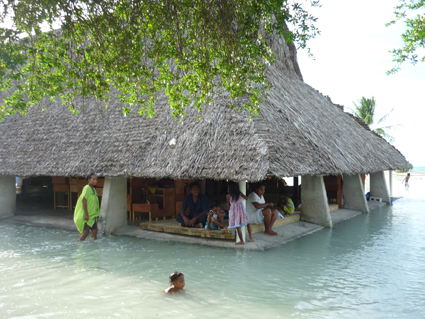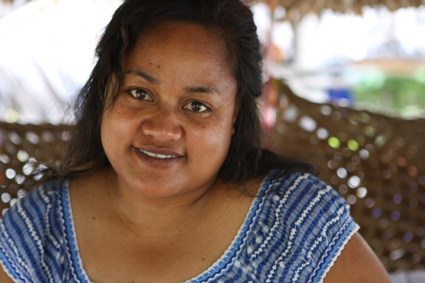a nation slips under the waves
dan edwards: tom zubrycki’s the hungry tide, melbourne film festival

Tebekenikora Village, The Hungry Tide
IS THERE ANY GREATER SIGN OF AUSTRALIA’S GLIB ISOLATION FROM WORLD AFFAIRS THAN THE LOCAL ‘DEBATE’ OVER CLIMATE CHANGE? WHILE HUGE SWATHES OF THE WORLD’S POPULATION ARE ALREADY HAVING TO COPE WITH THE DIRECT CONSEQUENCES OF A WARMING PLANET, HERE IN AUSTRALIA THE QUESTION OF WHETHER GLOBAL WARMING IS EVEN HAPPENING IS STILL TREATED AS A SERIOUS ONE. INTO THIS DIVIDED DISCOURSE STEPS TOM ZUBRYCKI’S NEW FEATURE-LENGTH DOCUMENTARY, THE HUNGRY TIDE, A PORTRAIT OF SYDNEY-BASED ACTIVIST MARIA TIIMON AS SHE WORKS TO DRAW ATTENTION TO THE PLIGHT OF HER PACIFIC ISLAND NATION KIRIBATI, WHICH IS ALREADY BEING INUNDATED BY RISING TIDES.
“I’ve been following the climate debate for a number of years and became very interested in the countries on the frontline,” says veteran director Zubrycki. “Kiribati and its neighbor Tuvalu are expected to be the first nations in the world to disappear as a result of climate change, so this was the trigger and motivation to make the film. The next step was to personalise the issue and find a narrative.”
Into this breach stepped Tiimon, an advocate with the Pacific Calling Partnership NGO based at the Edmund Rice Centre in Sydney. As the film opens, she is preparing to journey to Copenhagen in late 2009 to represent her nation at the United Nations Conference on Climate Change.
“Kiribati seems at the very edge of the earth for most Australians, yet it is only just east of Bougainville,” Zubrycki says of Maria Tiimon’s homeland. The country’s 33 atolls are an average of only two metres above sea level. Given that even optimistic forecasts predict a rise of 0.8 metres by the end of this century, it’s likely that Kiribati will be virtually uninhabitable by the time today’s babies reach old age.
Despite the severity of the threat, Maria is initially quite shy in her advocacy role, and part of the film’s journey is her growth as a media performer over the 12 months Zubrycki follows her. “Maria was the total opposite of Ramos Horta,” the director says, referring to his 2000 film The Diplomat, a classic portrait of the East Timorese leader. “Horta was driven by ego and the unshakeable belief that history was on his side. For Maria, being an advocate for her country was something thrust on her. She was a little reluctant at first, even though she believed passionately in the cause.”

Maria Tiimon, The Hungry Tide
Despite Maria’s shyness, Zubrycki manages to build an easygoing intimacy with her, based on a mixture of observational footage and casual verbal interactions. It’s a style that has served him well over the course of more than a dozen films, lending a personal dimension to his broader socio-political concerns. Recalling his early days in Sydney’s community video movement and the influence of US documentarians like Frederick Wiseman and Richard Leacock, Zubrycki explains, “I was restricted by budget so I could never do ‘pure’ direct cinema. So I developed a signature style which was a mix of direct cinema, interview and montage.”
The personal encroaches on the political in The Hungry Tide as Maria is torn between her family in Kiribati and her role on the world stage. These personal conflicts provide an involving emotional sub-plot and counterpoint to the broader dilemma faced by her nation.
As we follow Maria home to Kiribati just before the Copenhagen conference, the stark global inequalities driving the climate change phenomenon become all too apparent. From the luxury of life in Australia we are plunged into the basic existence of the Kiribati people, where even the arrival of a television set in Maria’s brother’s home is a major event. “It was only when I got to know Maria better that I became aware of the pressures from her family back on the islands,” says Zubrycki. “She was supporting two families in fact—her extended clan on her home island of Beru and her brother and his eight kids in the impoverished, overcrowded Kiribati capital Tarawa. She was living two lives and trying to find a balance between them.”
The stark impression of a global pecking order is only reinforced by the scenes in Copenhagen. The Kiribati delegation is forced by budgetary restraints to stay two hours out of the city and Maria has to double as a dancer at the nation’s press conference because they can’t afford to fly in a professional troupe. As we follow the backstage machinations from the Pacific Islanders’ perspective, we hear of the intense pressure applied by Canberra to these nations to withdraw their demand for a legally binding treaty—a manoeuvre barely mentioned in the post-conference rush to blame the dismal outcome on China.
Meanwhile, back in Kiribati the tide steadily encroaches on coastal settlements, roads and agricultural lands. “It struck me as a great irony,” Zubrycki comments wryly, “that Kiribati has contributed least to global carbon emissions but has the most to lose in terms of its vulnerability.” Unlike The Diplomat, which concluded with Ramos-Horta’s dramatic return to an independent East Timor after 25 years in exile, The Hungry Tide documents an ongoing struggle that is both more complex and potentially more devastating in its outcomes. Yet as Zubrycki notes, “Kiribati is not even on the radar for most Australians.”
Despite the vital role documentaries like The Hungry Tide play in bringing under-represented issues to public attention, Zubrycki remains frustrated with what he sees as a reluctance on the part of local broadcasters to back films with a regional focus. “For reasons that are beyond me, broadcasters believe their current affairs teams can cover Asia and the Pacific much more efficiently,” he says ruefully.
The fact that Kiribati’s plight is barely known in Australia contradicts the broadcasters’ belief—and illustrates why long-form documentaries are so important. It’s a testament to Tom Zubrycki’s skill as a filmmaker that he has touched upon so many vital issues in his career, through such intimate portraits of personalities big and small. Reporting the facts is important, but it’s our understanding of the people behind the headlines that can sow the seeds of real engagement—and in the longer term, the possibility of real change.
The Hungry Tide, director, producer Tom Zubrycki, 2011, Melbourne International Film Festival, July 21–7 Aug 7; www.miff.com.au
The Hungry Tide will screen in Sydney and Melbourne cinemas in late November. A 52-minute version will be shown on SBS 9.30pm, Sunday, Oct 9.
RealTime issue #105 Oct-Nov 2011 pg. 25






